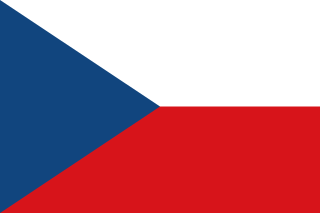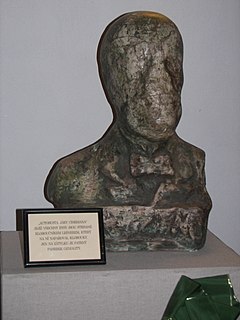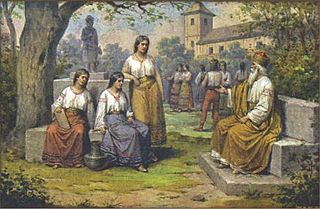 W
WCzech culture has been shaped by its geographical position in the middle of Europe. Influences from its neighbours, political and social changes, wars and times of peace all left its mark on the Czech culture. Prague's significance as a European cultural center rose and fell throughout history, but the Czech culture remains distinct to this day.
 W
WCéčka were plastic toys from Czechoslovakia popular in the 1980s and 90s, formerly used as parts of door hangings.
 W
WJára Cimrman, also known as "the Master", is a fictional Czech polymath, created by Ladislav Smoljak, Jiří Šebánek and Zdeněk Svěrák. The fictional personality is presented as a universal genius, and one of the greatest Czech playwrights, poets, composers, teachers, travellers, philosophers, inventors, detectives, mathematicians, and sportsmen of the 19th and early 20th century. Playing along with the pretence of his real existence is part of his characterization.
 W
WCzech art is the visual and plastic arts that have been created in the present day Czech Republic and the various states that occupied the Czech lands in the preceding centuries. The Czech lands have produced artists that have gained recognition throughout the world, including Alfons Mucha, widely regarded as one of the key exponents of the Art Nouveau style, and František Kupka, a pioneer of abstract art.
 W
WCzech traditional clothing expresses Czech history relative to Czech culture and behaviour. Czech folk clothing may be divided into two groups: the Western style in Bohemia and mid-Moravia, and the Eastern style in Moravia and Silesia. In both regions, clothes were made from wool and homespun linen. During summer, Czechs wore lightweight fabrics such as silk. Women’s traditional clothing consisted of two aprons, tied in the front and back, and a white blouse. For men, a typical outfit included long breeches and a loose jacket.
 W
WTramping is a movement incorporating woodcraft, hiking/backpacking/camping and scouting, with a characteristic flavour of and styled on American culture, especially the Wild West. The latter is particularly noticeable in the tramping song, a song and musical style associated with tramping.
 W
WDuke Krok is a legendary figure in Czech history, being the first judge, or duke, of the Czech people. He was also the father of Princess Libuše and her sisters Kazi and Teta.
 W
WExternism is a fictional philosophical theory proposed by the fictional Czech genius Jára Cimrman. This character appears in many plays by authors from the Jára Cimrman Theatre in Prague. The first act of the theatre performances is usually filled with a lecture on Cimrman's personality, followed by a theatrical play. The theory of externism is described in a monologue by a Cimrmanologist having a lecture on Jára Cimrman's significance in the field of philosophy in the first act of the theatre play Akt by Zdeněk Svěrák, Ladislav Smoljak and Jiří Šebánek.
 W
WHedgehog in the Cage is a mechanical puzzle popular in the Czech Republic which features prominently in the "Dobrodružství v temných uličkách" trilogy of adventure stories by Jaroslav Foglar. The puzzle consists of a small sphere with protruding spikes of various lengths contained within a cylinder perforated with holes of different sizes. The challenge posed by the puzzle is how to release the sphere from the cylinder.
 W
WHonza is a very common Czech name which may be informally used interchangeably with Jan. It comes from German Johann(es) → Hans → Honza. Possible diminutives are Honzík or Honzíček.
 W
WKolyadka are traditional songs usually sung in Eastern Slavic, Central Europe and Eastern Europe countries during the Christmas holiday season which is typically between January 7 and 14. At the same time Ukrainians sing kolyadkas and schedrivkasuk between December 19 and January 19. Catholic Christians and Protestants living in these countries sing kolyadkas on and near Christmas Eve. It is believed that everything sung about will come true.
 W
WKroje are folk costumes worn by Czechs and Slovaks. Gothic influence is seen in tying shawls and kerchiefs on the head. Fine pleats and gathered lace collars typify the Renaissance era. From Baroque bell-shaped skirts to delicate Slavic patterns, these folk costumes show the complex growth of Czech and Slovak traditions.
 W
WLibuše (help·info), Libussa, Libushe or, historically Lubossa, is a legendary ancestor of the Přemyslid dynasty and the Czech people as a whole. According to legend, she was the youngest but wisest of three sisters, who became queen after their father died; she married a ploughman, Přemysl, with whom she founded the Přemyslid dynasty, and prophesied and founded the city of Prague in the 8th century.
 W
W"The Maidens' War" is a tale in Bohemian tradition about an uprising of women against men. According to legend, it took place sometime in the 8th century. It first appeared in the twelfth-century Chronica Boëmorum of Cosmas of Prague, and later in the fourteenth-century Dalimil's Chronicle.
 W
WMatice česká was a Czech publishing house and cultural institution, similar to other Slavic Matice institutions. It was an important milestone in Czech National Revival.
 W
WMole is an animated character in a series of cartoons created by Czech animator Zdeněk Miler. The premiere of the first short film with Mole took place at the Venice Film Festival in 1957. Since its inception, the cartoon has gained enormous popularity in many Central European countries, as well as India, China, Kazakhstan, Croatia, Denmark, Norway, Finland, Russia, Ukraine, Belarus, Iran, Iraq, and Japan.
 W
WThe National Archives is the central archive institution of the Czech Republic. It depends of the Ministry of the Interior. The institution have documents dating to the Early Middle Ages. It is located in Prague.
 W
WCzech philosophy, has often eschewed "pure" speculative philosophy, emerging rather in the course of intellectual debates in the fields of education, art, literature, and especially politics. A source drawing from literature, however, distinguished the Czech national philosophy from the speculative tradition of German thought, citing that it emerged from folk wisdom and peasant reasoning.
 W
WPíča, sometimes short piča or pyča [pɪtʃa], is a Czech and Slovak profanity that refers to the vagina similar to the English word cunt. It is often represented as a symbol of a spearhead, a rhombus standing on one of its sharper points with a vertical line in the middle, representing a vulva.
 W
WPig slaughter is the work of slaughtering domestic pigs which is both a common economic activity as well as a traditional feast in some European and Asian countries.
 W
WThe Ride of the Kings is a festival that is celebrated in Spring, at the Pentecost, in Moravia, the south-east of the Czech Republic. In 2011, it was added to the UNESCO Representative List of Masterpieces of the Oral and Intangible Heritage of Humanity.
 W
WThe Sokol movement is an all-age gymnastics organization first founded in Prague in the Czech region of Austria-Hungary in 1862 by Miroslav Tyrš and Jindřich Fügner. It was based upon the principle of "a strong mind in a sound body". The Sokol, through lectures, discussions, and group outings provided what Tyrš viewed as physical, moral, and intellectual training for the nation. This training extended to men of all ages and classes, and eventually to women.
 W
WA string bag, net bag, or mesh bag is an open netted bag. Mesh bags are constructed from strands, yarns, or non-woven synthetic material into a net-like structure. String bags are used as reusable shopping bags and as packaging for produce.
 W
WIn the Czech Republic, 15–32 years old is the commonly used range for youth. The transition from youth to adulthood can be affected by increased years in non-compulsory education to the point of becoming financially independent. Estimated projections in 2013 of the total population of this range will be 1.8 million or 5.6% of the total population with 877,000 females and 923,000 males.
 W
WThe zmiovka, in Slovakia knowns as budajka is a traditional Czech knitted wool cap with no bill, encircled with a cuff and topped by a small pom-pom. The crown of the cap is characterized by thin stripes radiating from the pom-pom at the center. The most traditional color scheme for a Zmiovka is two-tone, with one of the colors being white and the other being black, brown, or red. Knitted into the cuff is a pattern in which smaller zig-zags are predominated by a large central zig-zag. The zig-zag is quite angular, but it has been so widely considered serpentine that the cap is most commonly called after a zmije, Czech for a viper, or more specifically a pit viper. The cap is less often referred to as hadovka, from the more general Czech word for “snake”.